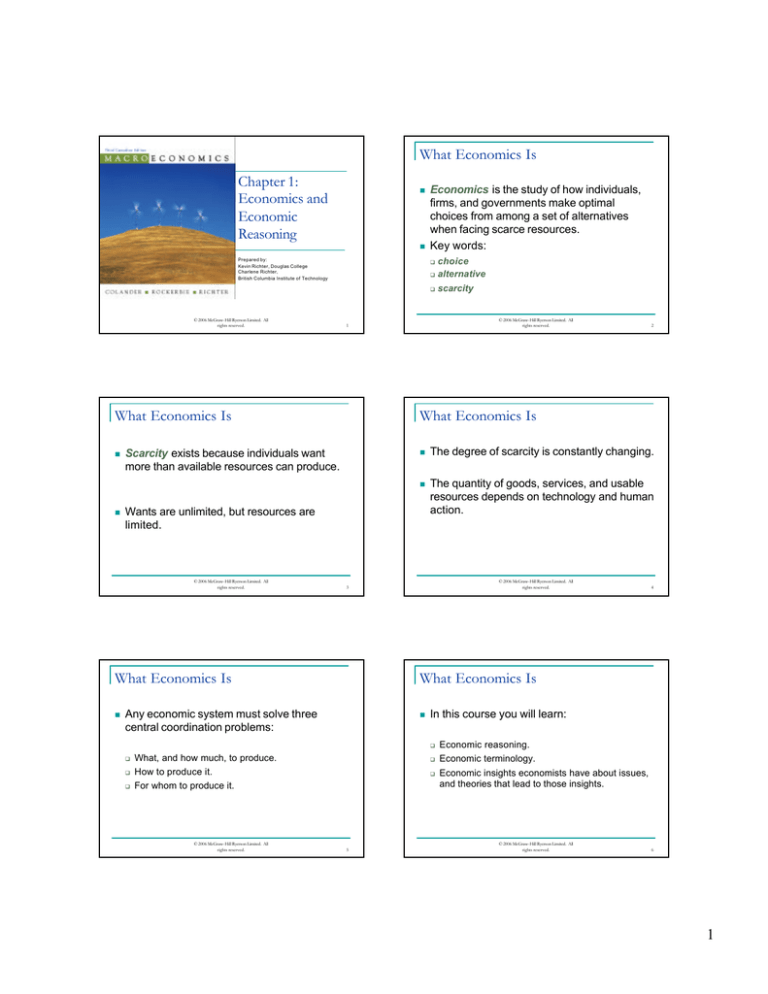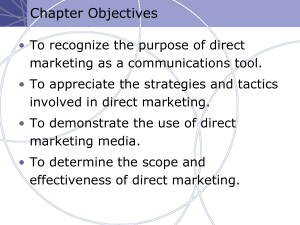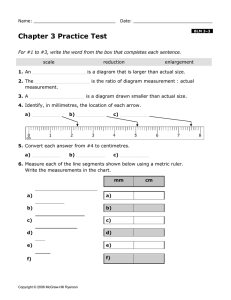
What Economics Is
Chapter 1:
Economics and
Economic
Reasoning
n
n
choice
alternative
q scarcity
Prepared by:
Kevin Richter, Douglas College
Charlene Richter,
British Columbia Institute of Technology
© 2006 McGraw-Hill Ryerson Limited. All
rights reserved.
q
q
n
n
The degree of scarcity is constantly changing.
n
The quantity of goods, services, and usable
resources depends on technology and human
action.
Wants are unlimited, but resources are
limited.
© 2006 McGraw-Hill Ryerson Limited. All
rights reserved.
3
What Economics Is
n
In this course you will learn:
q
q
q
What, and how much, to produce.
How to produce it.
For whom to produce it.
© 2006 McGraw-Hill Ryerson Limited. All
rights reserved.
4
What Economics Is
Any economic system must solve three
central coordination problems:
q
2
What Economics Is
Scarcity exists because individuals want
more than available resources can produce.
© 2006 McGraw-Hill Ryerson Limited. All
rights reserved.
n
© 2006 McGraw-Hill Ryerson Limited. All
rights reserved.
1
What Economics Is
n
Economics is the study of how individuals,
firms, and governments make optimal
choices from among a set of alternatives
when facing scarce resources.
Key words:
q
q
5
Economic reasoning.
Economic terminology.
Economic insights economists have about issues,
and theories that lead to those insights.
© 2006 McGraw-Hill Ryerson Limited. All
rights reserved.
6
1
What Economics Is
n
A Guide to Economic Reasoning
To understand the economy, you need to
learn:
q
Information about economic institutions.
q
Information about the economic policy options
facing society today.
© 2006 McGraw-Hill Ryerson Limited. All
rights reserved.
n
The relevant costs and benefits are the
expected incremental, or additional, costs
incurred and the expected incremental
benefits of a decision.
n
Economists use the term marginal when
referring to additional or incremental.
© 2006 McGraw-Hill Ryerson Limited. All
rights reserved.
n
Marginal cost – the additional cost to you
over and above the costs you have already
incurred.
n
This means not counting sunk costs – costs
that have already been incurred and cannot
be recovered.
© 2006 McGraw-Hill Ryerson Limited. All
rights reserved.
9
10
Marginal Costs and Marginal Benefits
Marginal benefit – the additional benefit
above and beyond what you’ve already
accrued.
© 2006 McGraw-Hill Ryerson Limited. All
rights reserved.
8
Marginal Costs and Marginal Benefits
Marginal Costs and Marginal Benefits
n
© 2006 McGraw-Hill Ryerson Limited. All
rights reserved.
7
Marginal Costs and Marginal Benefits
n
Economic reasoning is making decisions by
comparing costs and benefits.
n
11
According to the economics decision rule:
q
If the relevant marginal benefits of doing
something exceed the marginal relevant costs, do
it.
q
If the relevant marginal costs of doing something
exceed the relevant marginal benefits, don’t do it.
© 2006 McGraw-Hill Ryerson Limited. All
rights reserved.
12
2
Economics and Passion
Opportunity Cost
n
Economic reasoning is based on the premise
that everything has a cost.
n
n
It leads to a better society for the majority of
people.
n
n
© 2006 McGraw-Hill Ryerson Limited. All
rights reserved.
© 2006 McGraw-Hill Ryerson Limited. All
rights reserved.
13
Economic and Market Forces
The opportunity cost of the chosen activity
is the value of the next-best alternative to the
activity you have chosen.
Opportunity cost is the basis of cost/benefit
economic reasoning.
In economic reasoning, opportunity cost must
be less than the benefit of what you have
chosen.
Economic and Market Forces
n
The opportunity cost concept applies to all
aspects of life.
n
When goods are scarce, they must be
rationed.
n
It is fundamental to understanding how
society reacts to scarcity.
n
Rationing is the mechanism for determining
who gets what.
n
“There is no free lunch.”
© 2006 McGraw-Hill Ryerson Limited. All
rights reserved.
Economic forces (the invisible hand).
q
Social and cultural forces.
q
Political and legal forces.
© 2006 McGraw-Hill Ryerson Limited. All
rights reserved.
16
Economic and Market Forces
Economic reality is controlled by three forces:
q
© 2006 McGraw-Hill Ryerson Limited. All
rights reserved.
15
Economic and Market Forces
n
14
17
n
Economic forces are the necessary
reactions to scarcity.
n
A market force is an economic force that is
given relatively free rein by society to work
through the market.
© 2006 McGraw-Hill Ryerson Limited. All
rights reserved.
18
3
Economic and Market Forces
n
n
Economic and Market Forces
Market forces ration quantity by changing
prices: when there is a shortage, the price
goes up, when there is a surplus, the price
goes down.
n
What happens in society can be seen as a
reaction to, and interaction of, the invisible
hand, political and legal forces, and social
and cultural forces.
n
General insights into how economies work
are often based on generalizations called
economic theories.
n
Economic theories are abstract.
© 2006 McGraw-Hill Ryerson Limited. All
rights reserved.
19
Theories, Models and Assumptions
n
Economic model – a set of simple
behavioural assumptions to explain decision
making.
n
Economic principle – a commonly held
insight stated as a law or general
assumption.
© 2006 McGraw-Hill Ryerson Limited. All
rights reserved.
21
Theories, Models and Assumptions
22
Theories, Models and Assumptions
n
Economists cannot (usually) test their models
with controlled experiments.
n
It is impossible to physically hold “other
things constant,” as is done in laboratory
experiments.
This can be done with “natural experiments”
and complex statistical analysis.
© 2006 McGraw-Hill Ryerson Limited. All
rights reserved.
20
Theories, Models and Assumptions
A theory is often embodied in an economic
model or an economic principle.
© 2006 McGraw-Hill Ryerson Limited. All
rights reserved.
n
Political and social forces often work together
against the invisible hand.
The invisible hand is the price mechanism -the rise and fall of prices -- that guides our
actions in a market.
© 2006 McGraw-Hill Ryerson Limited. All
rights reserved.
n
n
23
n
Theories, models, and principles must be
combined with a knowledge of real-world
economic institutions to arrive at a specific
policy recommendation.
n
In order to understand the theory you must
understand the assumptions underlying the
theory.
© 2006 McGraw-Hill Ryerson Limited. All
rights reserved.
24
4
The Invisible Hand Theory
n
The Invisible Hand Theory
Economist have observed:
q
Price tends to fall when the quantity supplied is
greater than the quantity demanded.
q
Price tends rise when the quantity demanded is
greater than the quantity supplied.
© 2006 McGraw-Hill Ryerson Limited. All
rights reserved.
According to the invisible hand theory, a
market economy, through the price
mechanism, will allocate resources efficiently.
n
Efficiency means achieving a goal as
cheaply as possible.
© 2006 McGraw-Hill Ryerson Limited. All
rights reserved.
25
Economic Theory and Stories
Economic theory and its models are a
shorthand means of telling a story.
n
If you can’t translate a theory into a story, you
don’t understand the theory.
n
Economics is divided into two parts:
microeconomics and macroeconomics.
© 2006 McGraw-Hill Ryerson Limited. All
rights reserved.
27
Microeconomics
28
Macroeconomics
n
Microeconomics is the study of individual
decision making.
n
Macroeconomics is the study of the
economy as a whole.
n
It considers household and business
decisions, market allocations and pricing
policies.
n
It considers the problems of inflation,
unemployment, business cycles, and
economic growth.
© 2006 McGraw-Hill Ryerson Limited. All
rights reserved.
26
Microeconomics and Macroeconomics
n
© 2006 McGraw-Hill Ryerson Limited. All
rights reserved.
n
29
© 2006 McGraw-Hill Ryerson Limited. All
rights reserved.
30
5
Economic Institutions
Economic Institutions
n
In applying economic theory to reality, you
must know about economic institutions.
n
Economic institutions differ significantly
among nations.
n
Economic institutions are the laws,
common practices, and social, political, and
religious organization, of a society.
n
They sometimes seem to operate in ways
quite different than economic theory predicts.
© 2006 McGraw-Hill Ryerson Limited. All
rights reserved.
Economic Policy Options
n
Objective policy analysis keeps the value
judgments separate from the analysis.
n
Subjective policy analysis is that which
reflects the analyst’s view of how things
should be.
n
To carry out economic policy effectively, one
must understand how the economic policy
might change institutions.
n
Also, how might changes in institutions affect
the economy.
© 2006 McGraw-Hill Ryerson Limited. All
rights reserved.
33
Objective Policy Analysis
n
34
Objective Policy Analysis
n
To make clear the distinction between
objective and subjective analysis, economics
is divided into three categories:
q
q
q
© 2006 McGraw-Hill Ryerson Limited. All
rights reserved.
32
Economic Policy Options
Economic policies are actions taken by
government to influence economic events.
© 2006 McGraw-Hill Ryerson Limited. All
rights reserved.
© 2006 McGraw-Hill Ryerson Limited. All
rights reserved.
31
35
Positive economics
Normative economics
Science of economics
© 2006 McGraw-Hill Ryerson Limited. All
rights reserved.
36
6
Objective Policy Analysis
n
Positive economics – the study of what is,
and how the economy works.
n
Normative economics – the study of what
the goals of the economy should be.
© 2006 McGraw-Hill Ryerson Limited. All
rights reserved.
Objective Policy Analysis
37
n
Science of economics – the application of
the knowledge learned in positive economics
to achieve the goals determined in normative
economics.
n
Some argue that it is difficult (if not
impossible) to maintain objectivity in the
science of economics.
© 2006 McGraw-Hill Ryerson Limited. All
rights reserved.
38
Policy and Social and Political Forces
n
The choice of policy options depends on
more than economic theory.
n
Political and social forces must be taken into
account when applying economic theory to
policy.
Economics and Economic
Reasoning
End of Chapter 1
© 2006 McGraw-Hill Ryerson Limited. All
rights reserved.
39
© 2006 McGraw-Hill Ryerson Limited. All
rights reserved.
40
7




